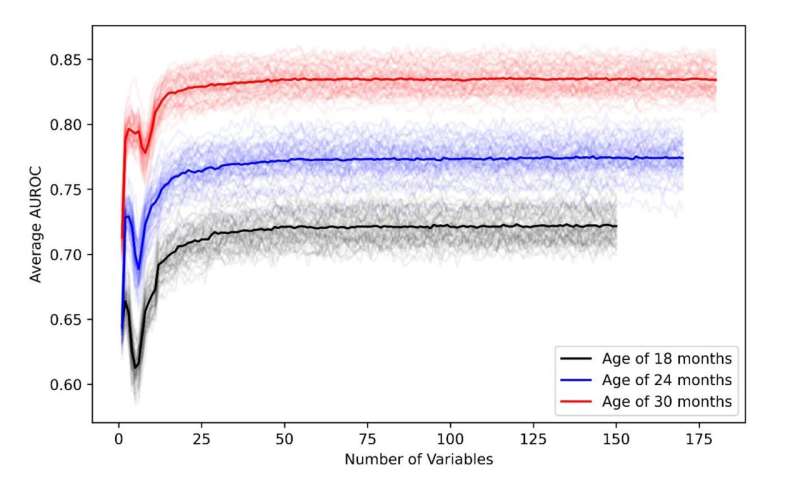Medical insurance claims might do more than help pay for health concerns; they could help predict them, according to new findings from an interdisciplinary Penn State research team published in BMJ Health & Care Informatics. The researchers developed machine learning models that assess the connections among hundreds of clinical variables, including doctor visits and health care services for seemingly unrelated medical conditions, to predict the likelihood of autism spectrum disorder in young children.
"Our new model, which quantifies the sum of identified risk factors together to inform the likelihood level, is already comparable to—and in some cases even slightly better than—the existing screening tool," Chen said. "When we combine the model with the screening tool, we have a very promising approach for clinicians."
According to Liu, it would be practically feasible to integrate the model with the screening tool for clinical use.
"A unique strength of this work is that this clinical informatics approach can be easily incorporated into the clinical flow," Liu said. "The prediction model could be embedded in a hospital's Electronic Health Record system, which is used to chart patient health, as a clinical decision support tool to flag the high-risk children so that both clinicians and the families could take actions sooner."
Chen is working with Whitney Guthrie, clinical psychologist at the Children's Hospital of Philadelphia Center for Autism Research and assistant professor of psychiatry and pediatrics at the University of Pennsylvania Perelman School of Medicine.
They are analyzing precisely how well the combined hospital record data and screen results predict autism diagnoses, as well as exploring other potential screening tools that could better equip clinicians to help their patients.
"Not only is the current tool missing many children on the autism spectrum, but many children who are detected by our screening tools experience long waitlists because of our limited diagnosis capacity," Guthrie said.
"Although it does detect many children, the M-CHAT also has very high rates of false positives and false negatives, which means that many autistic children are missed, and other children are referred for an autism evaluation when they may not need one. Both problems contribute to the long wait—often many months or even years—for further evaluation."
"The consequences for children who are missed by our current screening tools are particularly important because delayed diagnosis often means that children miss the window for early intervention entirely. Pediatricians need better screening tools to accurately identify all children who need an autism evaluation as early as possible."
Part of the problem is the limited number of psychologists, developmental pediatricians and other experts in pediatric development who can make an autism spectrum disorder diagnosis. According to Chen, the solution may exist in industrial engineering.
"The key idea is improving how we use resources," Chen said. "With Dr. Guthrie's clinical expertise and my group's modeling capabilities, we aim to develop a tool that primary care physicians without specialized training can apply to make confident assessments to diagnose children as early as possible in order to get the care they need as soon as possible."
More information: Yu-Hsin Chen et al, Early detection of autism spectrum disorder in young children with machine learning using medical claims data,
BMJ Health & Care Informatics (2022).
DOI: 10.1136/bmjhci-2022-100544
Citation: Medical history may help predict autism in young children, researchers find (2022, October 11) retrieved 12 October 2022 from https://medicalxpress.com/news/2022-10-medical-history-autism-young-children.html
This document is subject to copyright. Apart from any fair dealing for the purpose of private study or research, no part may be reproduced without the written permission. The content is provided for information purposes only.










 User Center
User Center My Training Class
My Training Class Feedback
Feedback












Comments
Something to say?
Log in or Sign up for free